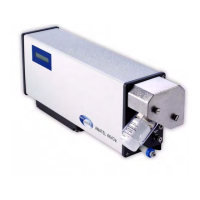Anatel A643a - Instrument Installation 35 of 220
RPS - June 2007 - Edition 12
Anatel Operator Manual
5) Make the connections to the appropriate terminals. Refer to the following Sections for
detailed information on the specific interface:
• “Printer Output” on page 111
• “Analog Outputs” on page 121
• “Digital Inputs & Outputs” on page 139
• “12 VDC Bias Output” on page 145
• “Serial Communications” on page 147
6) Replace the metal strain relief plate.
7) Replace the I/O Connector Block on the bottom of the Analyzer, taking care not to pinch
any wires, and secure it in place by tightening the screws.
The I/O Connector Block offers the following Anatel A643a input and output connections:
• A DB-25 Connector Block provides connections between the Analyzer’s electronics and
the I/O Connector Block.
Table 2-2 : Isolated I/O Connections
These connections are optically isolated from ground and the Analyzer’s internal power to avoid
potential problems.
NET
is used for Anatel A643a Network connections via the twinaxial BNC cable. The C80
Controller and the Anatel A643a–S are supplied with a 3-foot length of local A-Net cable;
cable for the Anatel A643a–P Analyzers is provided in their installation kits.
AUX
is reserved for Hach Ultra use.
4-20mA
furnishes a 4-20 or 0-20 mA output proportional to the Analyzer’s TOC reading for
external analog devices.
INPUTS
is a digital connection allowing limited supervisory control of the Analyzer by a remote
device or switch. Connecting to the “IN1*” terminal allows external initiation of a TOC
analysis cycle; “IN2*” determines whether the Analyzer is in the Auto TOC or the Purge
Mode.
OUTPUTS
provides a corresponding digital output for devices such as a remote alarm indicator or a
PLC (Programmable Logic Controller). Connecting to the “OUT1*” terminal reports on
whether the Analyzer’s TOC level is above or below the user-specified limit; “OUT2*”
reports whether its sample valve is opened or closed. Alternatively, “OUT2*” can be set
to report the status of the Uncompensated Conductivity Alarm.
Table 2-3 :
Non-Isolated I/O Connections
DATA ACQUISITION
is a bidirectional RS-232C interface that permits the Analyzer to interface
with serial devices such as a host computer.
PRINTER
outputs data to a local thermal or serial printer to generate hardcopy reports.
DIAGNOSTICS
is a secondary RS-232C port for reporting resistivity and temperature in a
4-20 mA format via an external DAC (Digital-to-Analog Conversion) Module.
This interface also may be used by Anatel Service Department personnel,
eliminating the need to disconnect other wiring in order to perform field
service procedures.
BIAS
furnishes 12 VDC, 0.5 Amp power for biasing digital inputs and outputs to
drive external devices like the auxiliary External DAC Modules.

